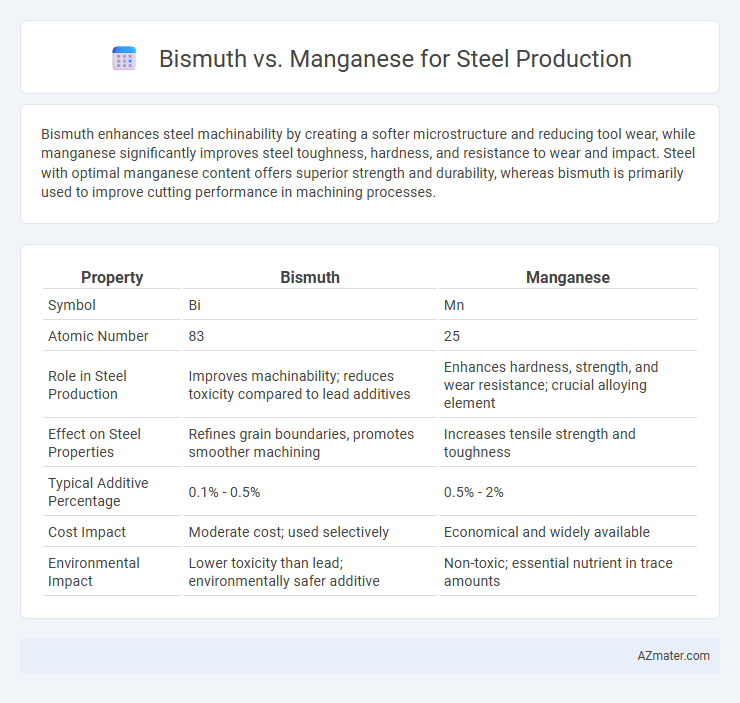Bismuth enhances steel machinability by creating a softer microstructure and reducing tool wear, while manganese significantly improves steel toughness, hardness, and resistance to wear and impact. Steel with optimal manganese content offers superior strength and durability, whereas bismuth is primarily used to improve cutting performance in machining processes.
Table of Comparison
| Property | Bismuth | Manganese |
|---|---|---|
| Symbol | Bi | Mn |
| Atomic Number | 83 | 25 |
| Role in Steel Production | Improves machinability; reduces toxicity compared to lead additives | Enhances hardness, strength, and wear resistance; crucial alloying element |
| Effect on Steel Properties | Refines grain boundaries, promotes smoother machining | Increases tensile strength and toughness |
| Typical Additive Percentage | 0.1% - 0.5% | 0.5% - 2% |
| Cost Impact | Moderate cost; used selectively | Economical and widely available |
| Environmental Impact | Lower toxicity than lead; environmentally safer additive | Non-toxic; essential nutrient in trace amounts |
Introduction to Alloying Elements in Steel Production
Bismuth and manganese are critical alloying elements in steel production, each enhancing steel's properties in unique ways. Manganese improves strength, hardness, and wear resistance by removing oxygen and sulfur impurities, making it essential in carbon and low-alloy steels. Bismuth, used in small amounts, enhances machinability by promoting chip breakage and reducing tool wear, especially in free-machining steels.
Overview of Bismuth and Manganese Properties
Bismuth and manganese exhibit distinct properties influencing their roles in steel production; bismuth is a heavy, brittle metal with a low melting point and excellent machinability enhancement, whereas manganese is a hard, transition metal vital for improving steel strength, hardness, and wear resistance. Manganese acts as a deoxidizer and desulfurizer, critical for removing impurities and preventing brittleness, while bismuth primarily aids in creating free-machining steel by modifying chip formation. The contrasting densities, atomic weights, and chemical behaviors of bismuth (density ~9.78 g/cm3, atomic number 83) and manganese (density ~7.43 g/cm3, atomic number 25) define their specialized applications in metallurgical processes.
Historical Use of Bismuth and Manganese in Steelmaking
Bismuth and manganese have played distinct roles in steel production historically, with manganese being a crucial alloying element since the 19th century to improve hardness, tensile strength, and toughness in steel. Bismuth, introduced in the late 20th century, has been used as a safer, environmentally friendly substitute for lead in free-machining steels, providing improved machinability without harmful health effects. While manganese remains essential for deoxidizing and controlling sulfur content, bismuth's adoption reflects evolving industrial priorities emphasizing sustainability and worker safety.
Impact of Bismuth on Steel Microstructure
Bismuth, when added to steel, significantly refines the microstructure by promoting the formation of fine, evenly distributed inclusions that improve machinability without compromising mechanical properties. Unlike manganese, which primarily acts as a deoxidizer and sulfur fixer to enhance toughness and strength, bismuth modifies the morphology of non-metallic inclusions to reduce tool wear during cutting processes. The presence of bismuth leads to a more homogeneous grain structure and reduced segregation, resulting in improved surface finish and dimensional accuracy in steel production.
Role of Manganese in Steel Strength and Hardness
Manganese plays a crucial role in steel production by enhancing its strength and hardness through its ability to improve tensile strength and impact resistance. It acts as a deoxidizer and helps remove sulfur and oxygen impurities, which prevents brittleness and improves the overall toughness of steel. Unlike bismuth, which primarily improves machinability, manganese significantly contributes to the structural integrity and durability of steel in construction and manufacturing applications.
Comparative Effects on Steel Machinability
Bismuth significantly enhances steel machinability by promoting the formation of softer, low melting point inclusions that act as chip breakers during cutting, reducing tool wear and improving surface finish. In contrast, manganese primarily serves as a deoxidizer and hardening agent, contributing less directly to machinability but improving tensile strength and toughness. Steel alloys containing bismuth exhibit superior machinability compared to manganese-enhanced steels, making bismuth a preferred additive in applications requiring precise and efficient machining performance.
Environmental and Health Considerations
Bismuth and manganese serve distinct roles in steel production, impacting environmental and health considerations differently. Manganese, essential for steel hardness and durability, can pose occupational health risks through inhalation of dust and fumes, causing respiratory issues and neurological effects, while its mining and processing contribute to environmental pollution. Bismuth, used as a safer alternative to lead for improving machinability, offers lower toxicity and reduced environmental hazards, making it a more sustainable choice for eco-friendly steel manufacturing.
Economic Factors: Cost and Availability
Bismuth is generally more expensive and less abundant than manganese, significantly impacting steel production costs. Manganese is widely available and cost-effective, making it a preferred choice for large-scale steel manufacturing. The higher market price and limited supply of bismuth restrict its use primarily to specialized steel alloys rather than bulk production.
Application Suitability: Choosing Between Bismuth and Manganese
Bismuth is ideal for steel production applications requiring improved machinability and reduced toxicity compared to lead, as it acts as an eco-friendly substitute enhancing chip breaking. Manganese, on the other hand, is essential for deoxidizing steel and improving its hardenability, tensile strength, and wear resistance, making it crucial for structural and high-strength steel grades. Selecting between bismuth and manganese depends on whether the primary focus is on machinability and environmental concerns or mechanical strength and durability in the final steel product.
Future Trends in Alloying Elements for Steel Production
Bismuth is emerging as a sustainable alternative to lead in steel production, offering improved machinability and environmentally friendly properties, while manganese remains essential for enhancing steel strength and toughness. Future trends emphasize reducing manganese content to lower environmental impact and integrating bismuth for better recyclability and compliance with stricter regulations. Research focuses on optimizing alloy compositions to balance performance with sustainability, leveraging bismuth's non-toxic characteristics alongside manganese's essential mechanical contributions.

Infographic: Bismuth vs Manganese for Steel production
 azmater.com
azmater.com